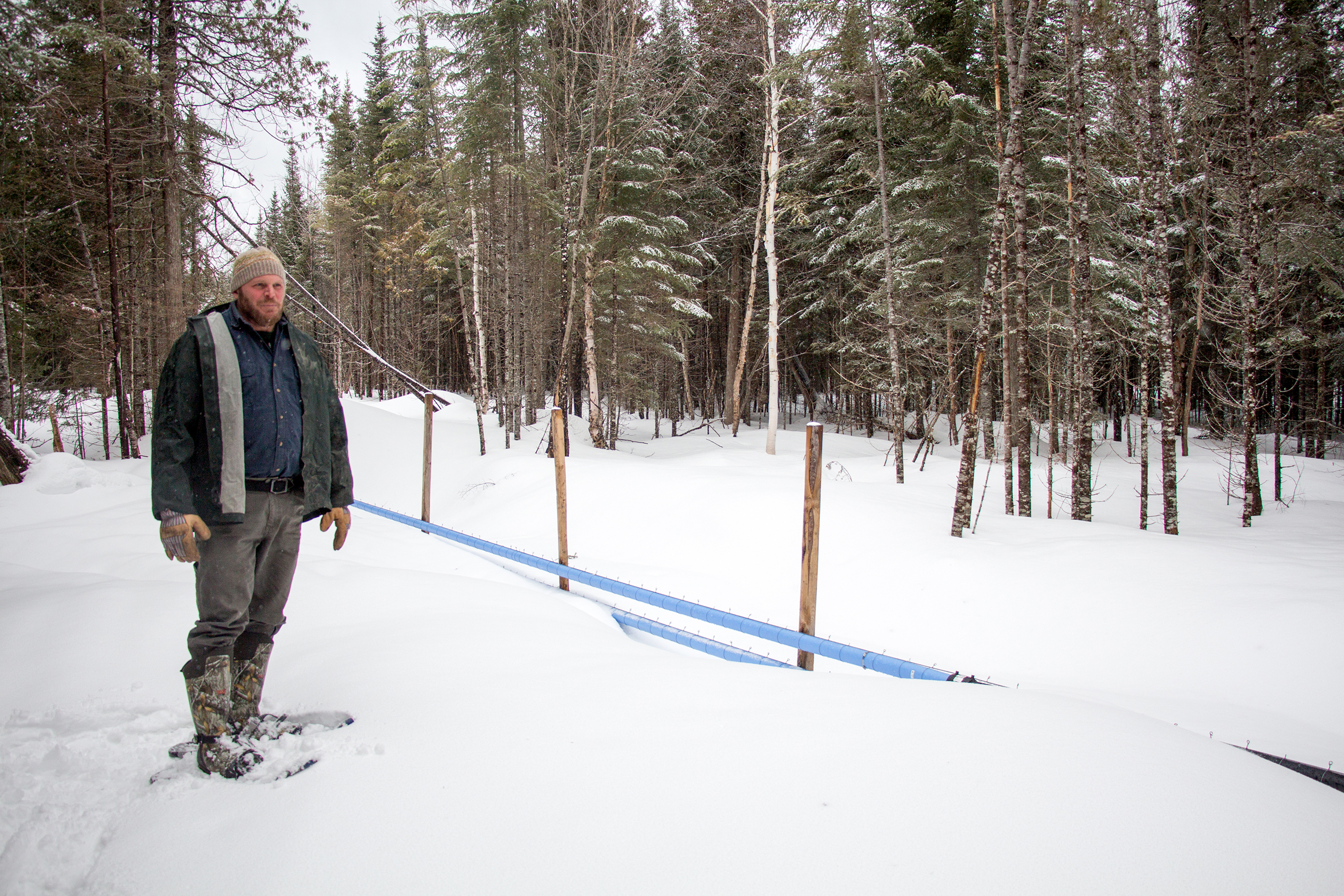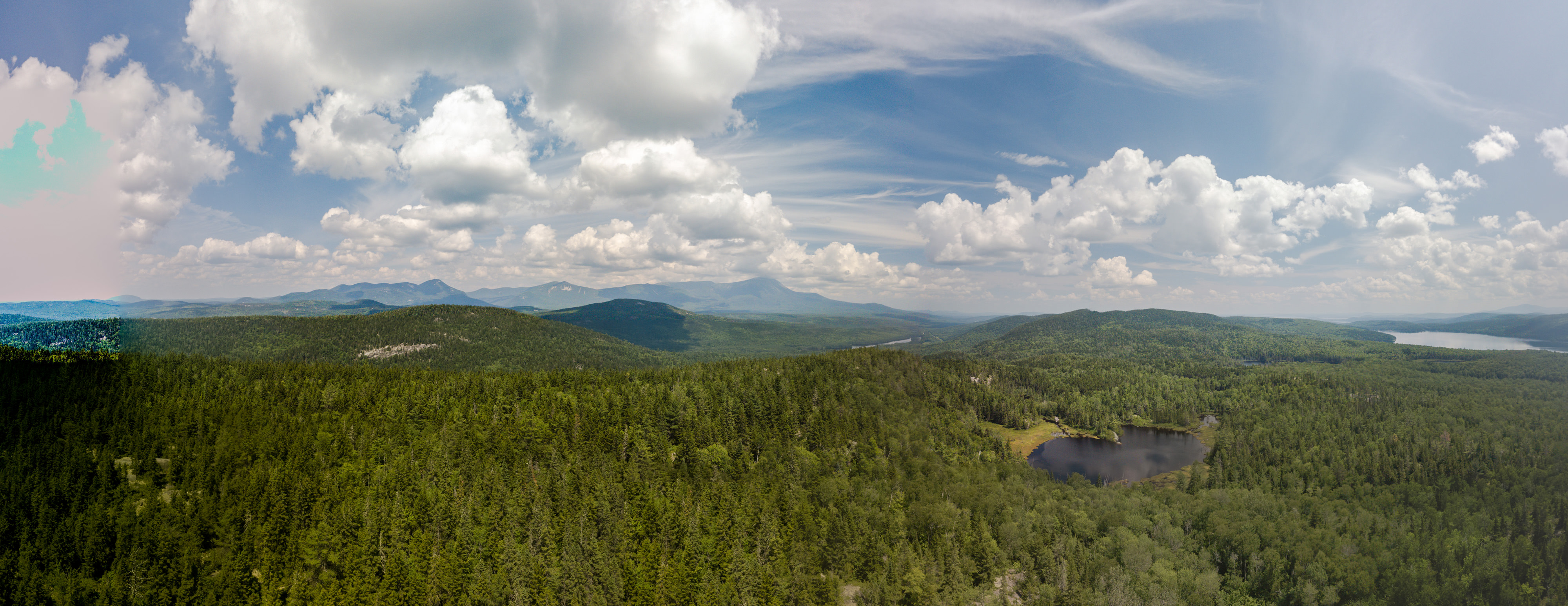The Life of a Conservation Forester
Applying cutting-edge land management in the remote Maine woods.
Chris Stone was driving his dark blue Ford F150 over the frozen gravel of a logging road in Maine's North Woods. He glanced to his left and admired the variety of trees speeding past. Hardwoods and softwoods, old giants and young saplings, these trees are the lifeblood for both people and nature in the most forested state in the country. As the Conservation Forester for The Nature Conservancy in Maine, it's Stone's job to care for them.
As he turned his attention back to the road, his gaze was quickly drawn to the right. There, running alongside his vehicle—was a moose! And the massive animal was matching the truck’s speed. A fierce and speedy debate ensued in Stone's head: Do I slow down and let the moose pull ahead? Or should I speed up and leave it behind? Either way, the moose might panic and veer into the truck. Making a split-second decision, Stone pressed down on the gas pedal and watched in his mirror as the moose jumped a snowbank and disappeared into the woods.
This was just another workday in TNC's St. John River Forest, where Chris Stone is responsible for managing more than 80,000 acres of working forest and monitoring another 80,000 acres of reserve land. Set aside for conservation and study of Maine’s ecosystems, reserve land provides important information about how forests develop and respond to natural challenges and support wildlife species. Big trees and older forests also hold a lot of carbon.
Quote: Chris Stone
The north Maine woods is a very different, wild and remote place.
Stone received his degree in forestry from the University of Massachusetts at Amherst and has worked as a forester since 2002. Prior to joining TNC in Maine, he was a Vermont County Forester and a private consultant. Both roles involved helping small, non-industrial private forest landowners responsibly manage their lands. Over the years, Stone has also worked on commercial fishing boats as both a fisherman and as a fishery observer for the National Marine Fisheries Service, as a wildland firefighter/chainsaw operator on numerous western fire details, and as a natural resource specialist with both the National Park Service and the U.S. Forest Service.
“I came to this job with a lot of forestry experience under my belt,” says Stone. “But the north Maine woods is a very different, wild and remote place. It is an excellent professional challenge and an amazing, beautiful and exciting place to be.”
Jack of All Trades
Stone's work trip reports often read like the journal entries of an explorer:
"Departed Millinocket at 7 a.m. There’s always a cold pocket on the Edmund Roy Road and it hit -11 according to the Ford’s thermometer. Arrived at Foss Brook Road and had to break trail through about 8 inches of crusty snow."
And a building contractor:
"Stopped at the NW Branch Bridge and inventoried the amount of channel iron, hardware and running planks required for repair."
And a forester:
"Wednesday afternoon we began laying out the proposed harvest by ground-truthing some of the less obvious stand boundaries and locating a nice isolated wetland in the middle of the area. After collecting data on the wetland boundary, we headed on throughout the stand discussing silviculture, habitat enhancements and operational considerations."

TNC has a modest office space in Millinocket, Maine, in the shadow of Mount Katahdin, and that's where Stone is based. From there, it takes almost three hours of gravel-road driving to reach the southern tip of the St. John River Forest property at the outlet of Baker Lake. With help from Northern Maine Stewardship Assistant Robbie Smith, Stone has been fixing up two old cabins that sit in a small clearing where the St. John River leaves the lake as a modest stream. From here, the St. John flows for 130 miles without passing a single settlement. The stream grows to a major river before crossing into Canada, and stands as one of the great wilderness canoe rivers in the eastern U.S. The refurbished cabins will act as a field office to make it easier to reach the northern portion of TNC’s property—another three-hour drive away.
A Landmark Conservation Success Story
In December 1998, The Nature Conservancy purchased 185,000 acres, including 35 miles of frontage on the upper St. John River, from International Paper for $35 million. This acquisition–the largest carried out by TNC anywhere in the U.S. at the time and the largest conservation land purchase in the northeast ever–changed the way much of the conservation community approaches land protection.
Today, more than 72 miles of the river and adjacent forest are conserved, by TNC and partners. In some areas on TNC's forest, limited, carefully designed and sustainable timber harvests help maintain regional economic opportunities, encourage new forest products development, and capture and hold carbon within the products themselves. In another, a sugarbush lease includes over 85,000 taps that produce 40,000 gallons of maple syrup annually! Producing this sweet and sustainable forest product provides revenue to support the costs of forest ownership and management while allowing the trees to mature and maintaining ideal habitat for interior forest-dwelling songbirds.

Recently, TNC has enrolled a significant portion of the preserve lands in a forest carbon storage project. This involved a long-term commitment by TNC to increase carbon stocking, accelerate the restoration of the forest, and increase the acreage dedicated to ecological reserves. The project also demonstrates the opportunity for landowners to blend carbon and forest-products revenue to achieve their objectives.
Managing a Sustainable Harvest
In the working forest portion of the property, Stone is currently implementing a multi-age management system that includes trees of varying ages, thereby more closely emulating an undisturbed forest. This plan is designed to retain many of the older trees while promoting the growth of younger trees and allowing new trees to become established, all while promoting characteristics of an older forest such as standing dead trees, trees that provide habitat features, and downed woody material on the forest floor.
“I think it’s important to have an approach towards active management that works in concert with the natural dynamics of the forest,” says Stone. “In addition to considering how the trees may react to the changes we make, we have to do our best to consider how the rest of the plant community, the wildlife, the soils, and the water will change as a result of our actions. I believe that active management, properly applied, can make a significant and valuable contribution to our conservation efforts in the St. John River Forest.”
One big concern when encouraging young trees to grow up here—is moose. Despite an outbreak of ticks that seems to have impacted survival rates for young moose, the overall population in this area is among the highest in the state. And moose really like to eat young trees, from the ground to as high as they can reach. TNC and neighboring landowners are working with the Maine Department of Inland Fisheries and Wildlife to manage the moose population in a way that results in healthier moose and more trees. When facing difficulties like this, Stone remains undaunted.
It's just one more challenge in the life of a conservation forester. And like rebuilding cabins, repairing bridges or ensuring that TNC forests are diverse and dynamic ecosystems that benefit people and nature, Chris Stone is up for it.


